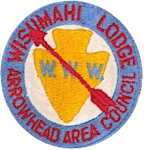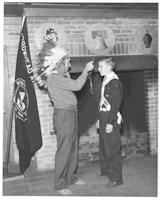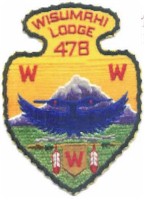Wisumahi Lodge #478
Long before white settlers happened upon the valley, San Bernardino was the home to Native Americans. When they cast their eyes to the north they could see an enormous landslide area shape like an arrowhead. Legend has it that those early inhabitants believed that the Great Spirit had been hunting deer one day and, having spotted a large buck, let loose a shaft. The deer, a wily old fellow, spotted the speeding shaft and bolted to one side, causing the arrowhead to dig deeply into the adjacent ground. It struck so hard and deep that it created a monumental arrowhead-shaped scar and hit an underground spring, creating a much needed source of water for the valley. To this day, the scar from that arrowhead can be seen on the hillside and the spring that it struck still delivers pure water of crystalline clarity.
So, it was quite logical when Boy Scouting came to the valley during the great growth years of Southern California, that the council should take on the name, Arrowhead Area Council. The environs within and surrounding the Council included many of nature's wonders: the San Bernardino Mountains, lush with evergreens and deciduous trees; cool, clear mountain lakes such as Gregory and Arrowhead; and great expanses of desert, pristine desert, that grew unimaginably hot in Summer, dry and pleasant during the Fall, cold on Winter nights, and in full bloom during magnificent, temperate Spring days.
These wondrous natural places became second homes to a growing group of young men and boys in the 40's and 50's as Boy Scouting expanded in importance. Then, as more and more Scouts took to the camps and trails, their leaders began to notice organizations within Scouting that encouraged and acknowledged superior camping skills, along with service to fellow Scouts. One such organization, recognized nationally, was the Order of the Arrow. Thus, it was on a summer day in 1952, under that great landmark arrowhead, which also marked the location of Camp Hilton, that Wisumahi Lodge #478 came into existence. The word, "Wisumahi" is from the Dakota (Sioux) language and means, Arrowhead, a name most appropriate for the lodge that took it.
 The Ordeal was under the auspices of San Gorgonio Lodge #298, from the neighboring Orange Empire Council of Santa Ana. From that day forward, there was always a special bond between those two lodges. As the Wisumahi's first Ordeal came to a close, the old-style felt sashes, emblazoned with crimson arrows, were placed over the shoulders of 16 new members of the Order. Wisumahi Lodge took life! Then, Skip Fife, representing San Gorgonio Lodge and the Order, placed a symbolic necklace around the neck of Larry Grace, the first Lodge Chief of Wisumahi. That necklace, elegant in its simplicity, was comprised of a leather thong and three wooden beads. It was passed on to each succeeding Wisumahi Chief.
The Ordeal was under the auspices of San Gorgonio Lodge #298, from the neighboring Orange Empire Council of Santa Ana. From that day forward, there was always a special bond between those two lodges. As the Wisumahi's first Ordeal came to a close, the old-style felt sashes, emblazoned with crimson arrows, were placed over the shoulders of 16 new members of the Order. Wisumahi Lodge took life! Then, Skip Fife, representing San Gorgonio Lodge and the Order, placed a symbolic necklace around the neck of Larry Grace, the first Lodge Chief of Wisumahi. That necklace, elegant in its simplicity, was comprised of a leather thong and three wooden beads. It was passed on to each succeeding Wisumahi Chief.
At the end of a Chief's term of office in recognition of his service, each was given a necklace to replace that leather thong. The necklace consisted of a sterling arrowhead suspended on a black ribbon. The face of the arrowhead featured the sculpted profile of the head of a Indian wearing a warbonnet, while the reverse side was inscribed with the name of the Chief, his year of service and the words, "Chief, Wisumahi Lodge".
Cheerful Service to one's fellow Scouts was the admirable goal of the Order. Wisumahi's members achieved this goal by tirelessly improving the Council's Summer Camp, Arataba. One of the first projects was to create a large campfire circle that could accommodate all of a session's campers. It became a focal point for many of the camp's activities and for sometimes-spectacular events. For 18 years Wisumahi's members devoted countless hours to Arataba: there were Spring work parties to ready the camp for summer; many of the Ordeal tasks were directed at shutting the camp down for the winter; and there was always work to be done inside the spacious lodge during the winter.
 It took a devastating fire that destroyed the lodge to bring an end to Camp Arataba. That fire, in 1960, initiated the final year at Arataba. And, of course, Wisumahi was there to make the camp the best place it could be under the circumstances. However, the Ordeal of 1960 marked the final days of Arataba.
It took a devastating fire that destroyed the lodge to bring an end to Camp Arataba. That fire, in 1960, initiated the final year at Arataba. And, of course, Wisumahi was there to make the camp the best place it could be under the circumstances. However, the Ordeal of 1960 marked the final days of Arataba.
Arataba's decline was compensated by the addition of Camp Running Springs to Arrowhead Area Council's assets. 1961, its Pioneer Year, was an opportunity for Wisumahi, once again, to serve the Scouts of the Council by turning to at the new camp. One year later, the camp was renamed Helendade in honor of its generous donor. From those early days until 1972, Wisumahi members continued the tradition of Cheerful Service at Helendade.
Click here for a listing of past Wisumahi Lodge Chiefs and Advisers


